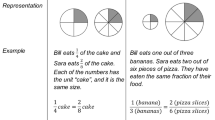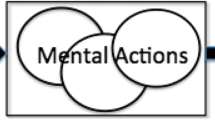Abstract
In the present study, we describe a participating student’s (Carol’s) distributive partitioning scheme and operations along with Steffe’s and his colleagues’ studies about children’s constructions of fraction knowledge as a particular model of mathematical learning. Analysis of Carol’s mathematical behaviors indicates that an operationally common mathematical behavior (distributive partitioning operation) was revealed in various mathematical problem situations such as fraction multiplication, fraction division, and multiplicative transformation between fractional quantities. It both provides a rationale for why becoming versed in one mathematical subject could facilitate working with another mathematical subject and also implies the necessity of describing and defining students’ mathematical behaviors from an operational view of knowledge, which might lead to building foundations of a substantial cognitive map for students’ mathematical development.
Similar content being viewed by others
References
Behr, M. J., Wachsmuth, I., Post, T. R. & Lesh, R. (1984). Order and equivalence of rational numbers: A clinical teaching experiment. Journal for Research in Mathematics Education, 15(5), 323–341.
Biddlecomb, B. D. (1994). Theory-based development of computer microworlds. Journal of Research in Childhood Education, 8(2), 87–98.
Biddlecomb, B. D. & Olive, J. (2000). JavaBars [Computer software]. Retrieved July 7, 2005 from http://jwilson.coe.uga.edu/olive/welcome.html
Confrey, J. & Lachance, A. (2000). Transformative teaching experiments through conjecture-driven research design. In A. E. Kelly & R. A. Lesh (Eds.), Handbook of research design in mathematics and science education (pp. 231–266). Mahwah, NJ: Erlbaum.
Hackenberg, A. J. (2010). Students’ reasoning with reversible multiplicative relationships. Cognition and Instruction, 28(4), 383–432.
Hackenberg, A. J. & Tillema, E. S. (2009). Students’ whole number multiplicative concepts: A critical constructive resource for fraction composition schemes. Journal of Mathematical Behavior, 28(1), 1–18.
Hall, R. (2000). Videorecordings as theory. In A. E. Kelly & R. A. Lesh (Eds.), Handbook of research design in mathematics and science education (pp. 647–664). Mahwah, NJ: Erlbaum.
Hunting, R. P., Davis, G. & Pearn, C. (1996). Engaging whole-number knowledge for rational-number learning using a computer-based tool. Journal for Research in Mathematics Education, 27(3), 354–379.
Kieren, T. E. (1992). Rational and fractional numbers as mathematical and personal knowledge: Implications for curriculum and instruction. In R. Leinhardt, R. Putnam & R. A. Hattrup (Eds.), Analysis of arithmetic for mathematics teaching (pp. 323–371). Hillsdale, NJ: Lawrence Erlbaum Associates.
Lamon, S. J. (1999). Teaching fractions and ratios for understanding. Hillsdale, NJ: Lawrence Erlbaum Associates.
Lamon, S. J. (2007). Rational numbers and proportional reasoning. In F. K. Lester (Ed.), Second handbook of research on mathematics teaching and learning (Vol. II, pp. 629–667). Reston, VA: National Council of Teachers of Mathematics.
Mack, N. K. (1990). Learning fractions with understanding: Building on informal knowledge. Journal for Research in Mathematics Education, 21(1), 16–33.
Mack, N. K. (2000). Long-term effects of building on informal knowledge in a complex content domain: The case of multiplication of fractions. Journal of Mathematical Behavior, 19(3), 307–332.
Mack, N. K. (2001). Building on informal knowledge through instruction in a complex content domain: Partitioning, units and understanding multiplication of fractions. Journal for Research in Mathematics Education, 32(3), 267–295.
Norton, A. & Wilkins, J. L. M. (2012). The splitting group. Journal for Research in Mathematics Education, 43(5), 557–583.
Olive, J. (1999). From fractions to rational numbers of arithmetic: A reorganization hypothesis. Mathematical thinking and learning, 1(4), 279–314.
Olive, J. (2001). Children’s number sequences: An explanation of Steffe’s constructs and an extrapolation to rational number of arithmetic. The Mathematics Educator, 11(1), 1–9.
Olive, J. & Steffe, L. P. (2002). Schemes, schemas and director systems—an integration of Piagetian scheme theory with Skemp’s model of intelligent learning. In D. Tall & M. Thomas (Eds.), Intelligence, learning and understanding in mathematics. Flaxton, Australia: Post Press.
Piaget, J. (1954). The child’s construction of reality. London: Routledge & Kegan Paul.
Pitkethly, A. & Hunting, R. P. (1996). A review of recent research in the area of initial fraction concepts. Educational Studies in Mathematics, 30(1), 5–38.
Shin, J. & Lee, S. J. (2010). Eighth graders’ use of distributive reasoning for multiplicative transformation of unit fractions. Paper presented at the 32st annual meeting of the North American Chapter of the International Group for the Psychology of Mathematics Education, Columbus, OH.
Steffe, L. P. (2001). A new hypothesis concerning children’s fractional knowledge. Journal of Mathematical Behavior, 20(3), 267–307.
Steffe, L. P. (2003). Fractional commensurate, composition, and adding scheme Learning trajectories of Jason and Laura: Grade 5. Journal of Mathematical Behavior, 22(3), 237–295.
Steffe, L. P. (2008). Radical constructivism and “school mathematics”. Rotterdam, the Netherlands: Sense.
Steffe, L. P. (2010). The partitive and the part–whole schemes. In L. P. Steffe & J. Olive (Eds.), Children’s fractional knowledge (pp. 75–122). New York: Springer.
Steffe, L. P., Cobb, P. & von Glasersfeld, E. (1988). Construction of arithmetical meanings and strategies. New York: Springer.
Steffe, L. P. & Olive, J. (1990). Children’s construction of the rational numbers of arithmetic. Athens, GA: National Science Foundation, University of Georgia.
Steffe, L. P. & Olive, J. (2010). Children’s fractional knowledge. New York: Springer.
Steffe, L. P. & Thompson, P. W. (2000). Teaching experiment methodology: Underlying principles and essential elements. In A. E. Kelly & R. A. Lesh (Eds.), Handbook of research design in mathematics and science education (pp. 267–306). Mahwah, NJ: Erlbaum.
Steffe, L. P. & Tzur, R. (1994). Interaction and children’s mathematics. Journal of Research in Childhood Education, 8(2), 99–116.
Steffe, L. P. & Ulrich, C. (2010). Equipartitioning operations for connected numbers: Their use and interiorization. In L. P. Steffe & J. Olive (Eds.), Children’s fractional knowledge (pp. 225–275). New York: Springer.
Streefland, L. (1991). Fractions in realistic mathematics education. Dordrecht, the Netherlands: Kluwer.
Thompson, P. W. & Saldanha, L. A. (2003). Fractions and multiplicative reasoning. In J. Kilpatrick, W. G. Martin & D. Schifter (Eds.), A research companion to principles and standards for school mathematics. Reston, VA: National Council of Teachers of Mathematics.
Tzur, R. (1999). An integrated study of children’s construction of improper fractions and the teacher’s role in promoting that learning. Journal for Research in Mathematics Education, 30(4), 390–416.
von Glasersfeld, E. (1982). An interpretation of Piaget’s constructivism. Revue Internationale de Philosophie, 36(4), 612–635.
von Glasersfeld, E. (1984). An introduction to radical constructivism. In P. Watzlawick (Ed.), The invented reality (pp. 17–40). New York: Norton.
von Glasersfeld, E. (1995). Radical constructivism: A way of knowing and learning. New York: Routledge Falmer.
Author information
Authors and Affiliations
Corresponding author
Rights and permissions
About this article
Cite this article
Lee, S.J., Shin, J. DISTRIBUTIVE PARTITIONING OPERATION IN MATHEMATICAL SITUATIONS INVOLVING FRACTIONAL QUANTITIES. Int J of Sci and Math Educ 13 (Suppl 2), 329–355 (2015). https://doi.org/10.1007/s10763-013-9478-9
Received:
Accepted:
Published:
Issue Date:
DOI: https://doi.org/10.1007/s10763-013-9478-9




